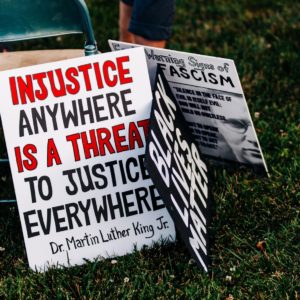To develop the next generation of civic leaders, educate children early and in age-appropriate ways about their identities and key concepts about race.
Anti-bias education is crucial for children of all ages. Identity-based biases lead to everyday forms of peer-to-peer harm. Sometimes the harm is verbal, sometimes physical, but always it is just the beginning for the ways young people practice how bias works in the real world. We need to help them understand that bias is a product of history, the legacies and ongoing ways that power shapes identities—who counts and who doesn’t.
And this isn’t just a problem in pre-K-12 education; anti-bias understanding is essential for the health of a fair and functioning multiracial democracy.
Understanding History to Build an Equitable Future
Even at the elite graduate school where we work—the Harvard Kennedy School—situated in some of the oldest buildings of private learning in the country, most of the students who walk through our doors do not know crucial facets of American history. Their working knowledge of the vast contributions of Black people, Indigenous communities and people of color to the United States is limited or even nominal. For international students, and in the countries they call home, marginalized racial and ethnic groups remain elusive as anecdotes in history books and as footnotes in national narratives about how countries came to be. Our U.S. pre-K-12 education system has failed to engage critically with these truths in its curricular aims to educate our youngest learners, the future adult citizens of our nation and the world.
The Southern Poverty Law Center’s Learning for Justice program has documented what histories do or don’t get taught to students of all ages, and the reports on Teaching Hard History and Teaching the Movement show how poorly the civil rights movement is taught in most states. A more recent survey of how well social studies teachers engage with the history of U.S. slavery found abysmal results across a range of key concepts. Among the most disturbing was that only 8% of students could identify slavery as the central cause of the Civil War.
In the 2017 study “The Status of Black History in U.S. Schools and Society,” professor of social studies education LaGarrett J. King indicated this issue is pervasive among students in the U.S. And that finding is supported by Oberg Research, an independent research organization, which in 2015 found only one to two lessons or 8-9% of total class time is devoted to Black history in U.S. history classrooms. The average student graduating college cannot explain the Reconstruction era nor place the American Civil War in the correct 20-year time frame.
As a country, we need to make the critical connection between the lack of teaching Black and marginalized groups’ histories and the lack of understanding of these histories and their significance for racial identity. And we must recognize the potential outcomes of teaching those histories, especially in producing children and adults who are more racially aware and informed, behave in more equitable ways, and are better future civic leaders and decision-makers.
The Need for a Complete and Honest Education
For most students in pre-K-12 public education, if they are taught Black history, it is as an add-on, not integrally woven into the core curriculum. As journalist Nikole Hannah-Jones, creator of the 1619 Project, notes, “Slavery touches almost every aspect of modern American life, yet it’s been an asterisk to the American story.” When it is taught, Black people are often presented as willing “immigrants,” rather than survivors of a global, racist, capitalist project of dehumanization. As educational studies professor Jeffrey Aaron Snyder indicates, not only is Black history ignored, willfully obscured or whitewashed, it is also taught as not relevant and not important for attaining a complete education.
A complete education is an honest education. Honesty requires people in the U.S.—especially adults and parents, who make up the decision-making bodies of our educational and political institutions—to commit to changing the ways historical narratives are taught and imbued. But the numbers indicate many adults are unsure there is even a problem.
When asked if racism is a problem in the U.S. today, 28% of American adults said it is minor, while 14% indicated they think it is not a problem at all, according to a 2022 CBS News poll. For white adults, 32% said it is a minor problem and 16% not a problem. Yet when all adults were asked how much Black history schools teach in the U.S., 11% responded “too much,” 24% said “the right amount,” and 23% were “unsure.” People in the U.S. are at a crossroads of cognitive dissonance when it comes to reconciling the racial disparities and inequities that exist today with our country’s racist history and the continued lack of truth-telling, particularly in education.
Yet how can they reconcile this if they too did not learn Black history as children? How do we interrupt these patterns? The answer: We start early.
Educating Young Children About Race and History in Age-Appropriate Ways
Developing the next generation of civic leaders means educating them from early childhood, in age-appropriate ways, about their identities and key concepts about race.
The research is clear: Talking about race makes young people more prepared to address racial biases rather than more likely to perpetuate them. Researchers have documented that children are as young as 3 months old when they start noticing differences in skin color, and by 3 years old, they express explicit racial biases. By age 4 or 5, white children are more likely to choose other white children as friends.
Talking to young children about skin color normalizes differences and teaches children appreciation for and awareness of racial diversity. Furthermore, talking to children in age-appropriate ways about visual differences they already notice helps to normalize these discussions. This approach disproves the discourse that talking about race makes children more racist or that it is better to maintain racial “colorblindness.” And the same is true for other identity differences, including sexuality, gender, ability and religion.
“Anti-bias education is not just doing occasional activities about diversity and fairness topics (although that may be how new anti-bias educators begin),” write education specialists Louise Derman-Sparks and Julie Olsen Edwards, regarding early childhood educators. “To be effective, anti-bias education works as an underpinning perspective, which permeates everything that happens in an early childhood program—including your interactions with children, families and coworkers—and shapes how you put curriculum together each day.”
Racial socialization exists in the classroom, as well as through the myriad forms of social messaging and cultural expression in the U.S., and goes beyond the family unit, from media to products and toys and day-to-day interactions with communities and social institutions. Also, children quickly learn from observing how racial, ethnic and nationality differences map on to social status—who works for whom, who takes orders and who follows them. Children are not racially “colorblind.” No one is.
As Margaret A. Hagerman, sociologist and author of White Kids: Growing Up With Privilege in a Racially Divided America, contends, “So while [children] may learn the social norms that it’s inappropriate to talk about race, it is unlikely that they have stopped thinking about it.” In U.S. society, children have been conditioned to see whiteness as the norm and a universal signifier of beauty. In children’s books, they are socialized to see white people with agency, as heroes of the story, whose lives matter. But Black, Indigenous and other children of color are too often missing from these stories, or are marginal characters, or are, at worst, the villains. The consequences have long been known, going back to the groundbreaking work of social psychologists Kenneth and Mamie Clark with their doll studies in the 1940s.
More recently, researchers have documented the ways in which both Black and white children aged 3 to 6 make choices in favor of whiteness. A false sense of superiority on one hand, and a feeling of inferiority on the other, is the consequence of learned behavior and repeated experiences.
The connection between learning about racial identity and promoting greater racial equity also exists for educators. Research shows that using race-specific language enables teachers to better identify and address racist dynamics related to school procedures, including discipline, compared to exchanges using race-evasive language. Additionally, school leaders who regularly use race-specific language as a part of their professional practice develop teams who are better equipped to address organizational disparities related to race and racism in schools as compared to those who do not.
Effectively teaching children to be critical thinkers and educated, engaged citizens requires active involvement of all educational stakeholders. In addition to teachers, this includes parents, school district leaders, school boards, educator-training institutions and community advocates. What we are missing is not the research on the effectiveness of critical race education—it’s the sustained implementation of successful examples of these efforts.

Teaching Critical Historical Truths Benefits Society
In seeking a link between teaching about uncomfortable but critical realities and positive effects on society, we need not look far. Sexual education—or “sex ed” as it’s come to be known in the U.S.—is a prime example of developing a curriculum around sensitive content that crucially supports children in positive, healthy identity-development with profound consequences for the public health of young people. In the United States today, 90% of parents support sex ed for high schoolers, and 75% for middle schoolers.
In a 2009 interview with Newsweek, professor of sociology Janice M. Irvine noted the paradox that sex ed addresses: “We have this massive sexualization of the media (just think of the movie American Pie), but we’re not allowed to talk about masturbation with teenagers.” Again, the research indicates the positive benefits of confronting uncomfortable truths: Teaching sexual health creates more body positivity and informed sexual decision-making, rather than the opposite. Sex ed teaches children not only to respect their own bodies but also the bodies of their peers in ways that diminish the spread of sexually transmitted diseases, teen pregnancy and bias against gender-nonconforming youth.
Sex education, like anti-bias education, is literally a matter of life or death.
An honest education is the minimum we should strive for as educators, one that is rigorous, too, and demands the historical truth-telling of Black history, Indigenous history, and the history of Asian Americans, Latinx Americans, Middle Eastern Americans and other marginalized groups. An honest education centers these histories and makes them integral to the core concepts of learning. At best, this education becomes a foundational component of critical thinking—not only teaching these histories but also asking students to consider and understand ideas such as: What does this mean for me and for my friends? What is my responsibility for ensuring I do no harm, consider the well-being of others and promote equity and democratic values?
Children will learn and transmit messages about race even if the adults in their lives remain silent. Hagerman notes: “My own research suggests that kids are talking about race, racism, and controversial current events with each other, whether their parents and teachers know it or not. Adults and educators must therefore provide young people with not only the necessary tools to help them understand race and racism but also the opportunity to be heard.” Moreover, the severity of racial segregation means that children of different racial identities grow up remote from one another. However, the intergroup contact produced by more racially integrated environments in which children learn and live has been demonstrated to reduce intergroup prejudice.
Building a Healthy Multiracial Democracy
Reckoning with truths about the United States is hard, but it is the only way to build a true multiracial democracy with leaders equipped to meet the demands of designing new societal structures and systems that promote fairness, equity and justice.
This work is needed now more than ever, as the baseline of these practices of educational equity is under attack. From 2021-22, in every state except Delaware, U.S. government officials introduced at least one anti-“critical race theory” measure, including bills, resolutions, executive directives, legislation, regulations and statements. Even where there are no statewide bans, restrictive measures are being enacted by local school boards. And at the national level, in June 2023, the Supreme Court struck down the strongest piece of federal policy linked to better equity in higher education: affirmative action.
In April 2023, the governor of Alabama fired Barbara Cooper, head of the Alabama Department of Early Childhood Education, for promoting Developmentally Appropriate Practice, a training manual for early childhood educators written by the nationally recognized National Association for the Education of Young Children. This was not a children’s book, nor part of the curriculum, yet the governor condemned its material as teaching “woke concepts” because of language about inclusion and structural racism.
These recent policy moves and political attacks undermine a healthy and functioning democracy and instill a climate of fear. Additionally, teachers, librarians and many university faculty members are forced to censor themselves and the materials they make available to students. If they choose to even mention structural racism, gender discrimination or sexuality, the action can cost them their job.
To break the historical cycle of oppression and to build a stronger and healthier multiracial democracy, all of us must embrace and affirm teaching that the struggle against racism and all forms of identity-based biases is foundational to the nation’s history and the expansion of freedom for all.
As developmental psychologist Sandra Waxman contends, “By arming parents, educators, service providers, and policymakers with scientifically grounded evidence about how bias develops, we support their positions as agents of change.”




